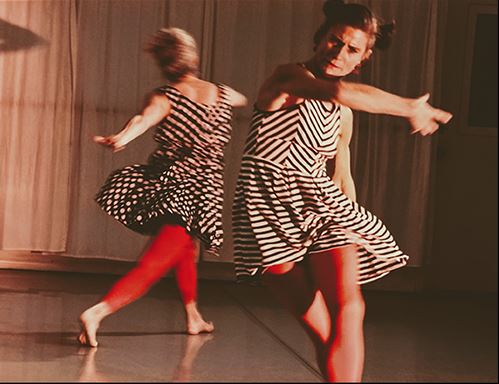A Body Steeped
Reflections on Sisters & druthers
BY TODD COURAGE
On November 12th, a number of rich ideas were unveiled at a mixed program of dance at Shawl-Anderson Dance Center in Berkeley. The concert, Sisters & druthers, was a mélange of new and old works by three women who seemed to share a past, by present geographies if not by life events. This overlap of circumstances was enough to lend cohesion to the assortment of aesthetics. History and location. Time and space. These themes dominated the night’s unfolding in ways both obvious and cloaked.
I was approached to write about my observations with some broad prompts that included recognizing the ages of the dancing choreographers – somewhere between 50 and 60, I’m guessing – and how, in such a small venue, this phenomenon might be enhanced by mere proximity. Older people, in your face, moving. The aging dancing body is a ‘hot topic,’ I was told, and therein lay the delicacy of my task.
What was hot, through my lens, was the reality of three strong-willed women bucking a weary stigma that the degenerating instrument – an aging body – is somehow less equipped to tell its story, or anyone else’s for that matter. I would argue otherwise. Wouldn’t a body steeped in decades of experience, scarred and marred by life’s travails and lunging toward any potential source of joy and fulfillment, act as an equally legitimate vessel of corporal knowledge and physical generosity? Or even be capable of more poignant nuances than the inchoate acrobatics of the fresh and nimble? Why would this tenet apply solely to a Stradivarius? Or a wine? Or an iron skillet?
For anyone aging (which includes every living person), narrowing the definition of dance as an activity reserved for the young can be a risky stance. Not only would that classification deny all people the right to make and do dance but, more insidiously, this gentrification of thought strangles the range of the field to the degree that it eventually excludes oneself.
For Carol Kueffer, Ann DiFruscia, and Chingchi Yu, there appeared to be no kowtowing to this reductive ideology. Instead, the point of interest, and really the thrust of the event, was not how long they had lived at all, but how much they have lived, and how deeply. In an ageist society, this facet was refreshing. Time was relevant only as it served accumulated experience.
How each of these choreographers betrayed their individual rejection of any marginalizing pigeonhole ran the gamut. Carol Kueffer opened the program with her piece Umami, “inspired by the tastes received by taste receptors…”. This group work began with a vignette involving a mature woman and a little girl sitting on a blanket and nibbling various morsels of food à la picnic. This innocent scene seemed to celebrate inclusion without capitalizing on the politics of aging. Kueffer set a tone that spelled out: “All are welcome.”
Her second piece, Earth, Blood, and Sky resonated more deeply for me. I believe this was because she presented herself in her own story: a granddaughter of an old woman, Armenian-American, the conduit of an ancient lineage, a practitioner of ritual, a custodian of tradition, a lover of dance. Her age was her most advantageous asset. A dance like this, one that speaks about a far-off memory and “access to some other world,” requires a lifetime.
Ann DiFruscia’s approach toward addressing her “now” ran perpendicular to Kueffer’s. DiFruscia recounted the bumpy road that formed her, from nun-run parochial schools to a boys-only Italian Boston neighborhood; from emerging as the complex by-product of “Dickensian abuse” to the disfiguring consequences of kidney stone surgery. But the piece, A Pound of Flesh, is much more than a list of hardships. It is a brave disclosure from a woman who has confronted life’s disintegrating nature and is reemerging whole. “Years of time yield understanding and forgiveness,” she says.
The third choreographer, Chingchi Yu, presented three works: two solos and a group piece. I appreciated Yu’s graceful spatial consideration and commentary on shared experience. Her most compelling presentation was a solo entitled Before Dawn. In measured contradiction, Yu used deadpan expressions and allusions to reveal the multi-dimensionality of her psyche, like a bas-relief sculpture borrowing from itself to provide depth. What we learn is that she is no stranger to lived performance and, characteristically, imbues her dances with imploring intensity and life-or-death urgency.
Kueffer, DiFruscia and Yu, although remarkably different, cooperatively summoned the courage to cut through the fetters of “old people dancing.” The audience was reminded to trade our fascination with callow expression for a more ancient way of being, based on reflection and succeeding wisdom that only a long life can yield.
Lisa Bush and Carol Kueffer in Kueffer’s Umami
~~
Todd Courage is a dancer, choreographer, student, and teacher in the Bay Area and abroad. He holds an MFA in dance from Saint Mary’s College, where he currently serves on faculty in the department of performing arts. He is also the artistic director of Courage Group in San Francisco.

